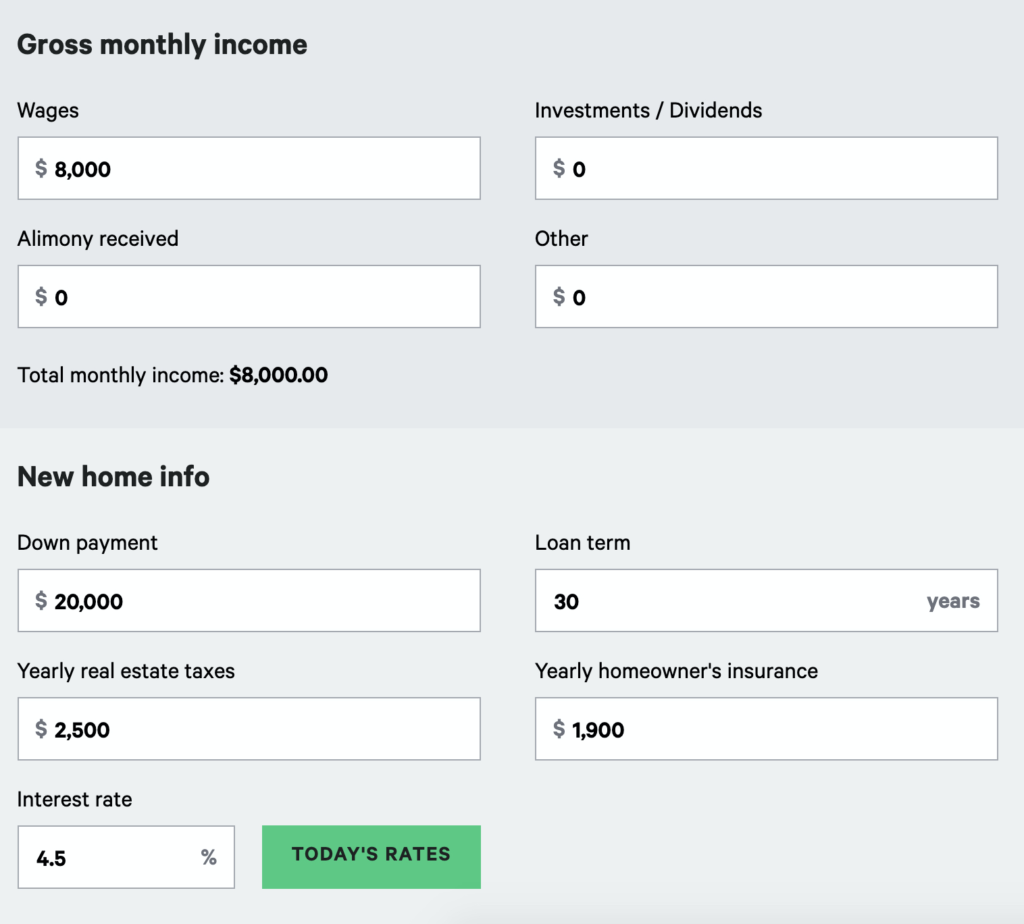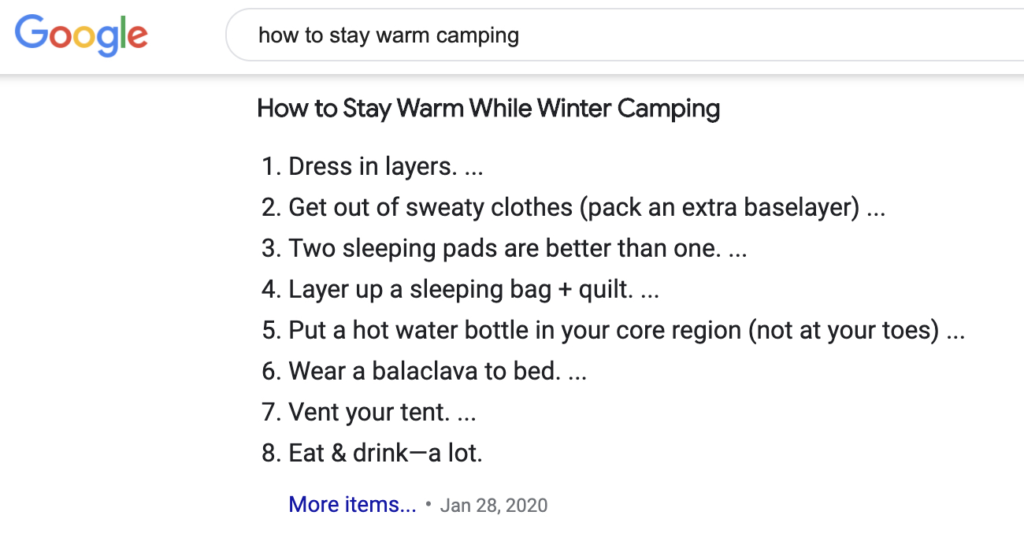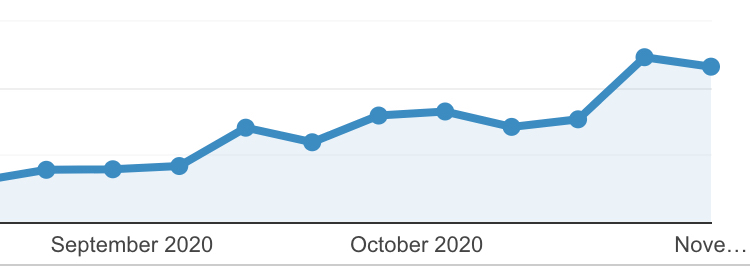
If you need to increase traffic to your website, the first thing many marketers do is write a new page. But there’s another way to earn traffic. It requires a fraction of the time commitment of a new blog: content refreshing.
What is Content Refreshing?
Content refreshing is the process of identifying webpages with the potential for increased organic traffic via search. This typically involves identifying pages on your site that either:
- Previously performed well, but traffic is down in recent months, or
- Rank for several target keywords outside of top positions and can earn more clicks by rising a few spots.
Steps to Refreshing Content
1. Identify Content for Optimization
A good place to start is in Google Analytics. Here you can find existing content that drove significant organic traffic in the past, but recently saw a drop. You can see the organic traffic of each blog post over a given period. The illustration below shows a web page that performed well, but saw a drop and has not fully recovered.

When you see this type of traffic drop, you should first try to learn the reason for the drop. For instance, seasonality can play a major role. Let’s say a given page historically peaked in the summer months, then saw little traffic in the winter. This would not be the best choice for a refresh. No amount of high search rankings in the winter is going to help it maintain its traffic.
Here’s a scenario when it makes sense for a content refresh: a competitor now outranks your page and stole clicks. This situation is perfect for a refresh. If you update the page, you could reclaim your position in search results and the increased traffic with it.
The other type of page eligible for a refresh is one ranking within “striking distance” of high-volume keywords. There’s not an exact science to what’s considered within striking distance. Generally, a page ranking for several keywords in positions four through 10 are a good fit. Your page could see a jump into the top three search rankings if you make the necessary updates.
For example, TrainingPeak.com’s page on “The Complete Marathon Training Guide” ranks in positions four through 10 for 46 keywords. Total search volume is estimated at 35,940 searches per month.

If it moved into the top three, they can earn a larger share of the thousands of clicks per month. This is a perfect opportunity for a refresh. A small jump in rankings across a few dozen keywords could be the difference in thousands of new sessions per month.
2. Create a New List of Target Keywords
Regardless of why your pages need a refresh, the next step is the same. Now you must create a new list of target keywords. This is a crucial portion of any content strategy tailored for SEO.
Using a tool such as Ahrefs or SEMrush, see which keywords the page ranks for in positions four through 10. The page will target those new keywords.
3. Analyze the Pages Ranking for Your New Target Keywords
The next step is learning what type of updates your page needs to earn or reclaim top three search rankings. Google each target keyword and analyze the pages ranking ahead of yours.
There is a reason Google is choosing to rank pages above yours, and it’s your job to find out why.
For example, Interest.com ranks sixth for “how much should i spend on a house.”
To learn what types of updates to make, they should review the five pages ranking above them to determine what ranking factors are influencing Google to see those pages as better fits for the query. It’s important to note the frequency of functional landing pages versus blog posts on the results page.
One obvious difference is that the content of the top pages includes a mortgage calculator. Readers can enter their income, expenses, home price and interest rate. Then the calculator gives them an estimate on the price of the home and mortgage payment they can afford.

It makes sense Google prioritizes pages with a calculator as the best answer to the query. This helps users learn an exact answer to their question, instead of reading broad principles about income percentages.
One update Interest.com should make while refreshing content is adding an interactive mortgage calculator to their landing page.
The key is to identify what the top pages have in common and include those elements on your page. Want to take it a step further? Don’t just match the content of those pages, instead provide even more helpful content.
As another example, REI.com ranks fourth for “how to stay warm camping”. This page is about 500 words and includes five tips for keeping warm, followed by a brief description for each.
By analyzing the content of the three pages ranking above it, some easy updates come to mind.
Pages one, two and three feature nine, 13 and 15 tips respectively and average 2,300 words. That’s an easy opportunity for REI to update their page to include 10-15 tips and 2,000+ words.
The site already has outdoor niche authority. Refreshing the content to be more comprehensive would likely cause a rankings jump.

4. Target the Featured Snippet
Featured snippets are the answer boxes at the top of search results. They attempt to answer the query without requiring the user to click through to the page. According to Search Engine Land, they appear in more than 12 percent of searches. Featured snippets are even more common for informational queries that are perfect for content refreshing.
You should intentionally target the featured snippet in your content refresh. Featured snippets increase your site’s prominence in search engine results, and could earn you a top ranking.
How do you target the snippet?
Look at the format of the current snippet. The primary formats of featured snippets are:
- Bulleted lists
- Numbered lists
- Paragraphs
When you’re refreshing your page, always include an answer to the query in the format of the current featured snippet.
In our camping example, the featured snippet is a numbered list.

So REI’s refresh of the page should maintain their current format of numbering their tips.
If the featured snippet is a paragraph, include a brief paragraph toward the top of the page directly answering the question. If it’s a bulleted list, either include a bulleted list on the page or include your answers to the query as H2 headers.
5. Watch Organic Traffic Rebound
Content refreshing has another benefit: you don’t need to wait as long to see a traffic increase.
When publishing new blog posts, expect to wait several months for pages to crack the top few positions. But with content refreshing, a page is often already ranking. You can see a traffic rebound in a matter of weeks.

Additionally, not every page on your site will be a hit. While some might get thousands of sessions per month, others might get only a few dozen. By opting for a content refresh instead of a new page, you are doubling down on high-ranking content. Thus, minimizing the risk of a low-performing page.

Work with a new kind of agency
At Silverback, we know content marketing and SEO go hand in hand. You need SEO to align your pages with Google’s ever-changing algorithms, plus the content team to execute these strategies effectively. Contact us to learn more about our digital marketing services.
AdAge, Inc Magazine and the Washington Post have recognized Silverback as one of the top places to work in the United States. Our secret is simple. Healthy teams lead to happy employees and happy clients. Silverback’s focus on team health leads to open, honest and direct communication between clients and staff alike. Issues are solved faster, expectations are clear, and results are impressive.
Recent Posts
The Evolution of SEO Content: Building Sustainable Strategies with AI
Read the ArticleThe Ongoing SEO Process: Tips + Best Practices
Read the ArticleWhy You Need Audience Research in SEO
Read the Article
Unlock Your Growth Potential
Silverback helps businesses catapult web traffic, leads, and sales. We combine analytical and creative expertise to drive inbound marketing campaigns and track it all to find insights on what worked, what didn’t, and what we should try out next.
Contact Us